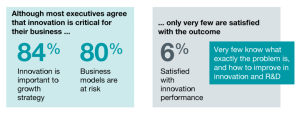My business partner and I have been in the broader “innovation” game for a while. While Ever Evolving is a fairly young venture, together we bring with us over 25 years of experience in helping companies adopt new ways of reaching customers and evolving the way their business works.
And, the reason that we started Ever Evolving, was that the more people we talked to, the more research we did, and the more people we worked with, we noticed that people kept bumping into the same 5 challenges. While some are certainly bigger or more challenging than others, they all lead to the same results.
Organizations are not getting what they want out of their Innovation Portfolio.
Says Who?
We aren’t the only ones who have noticed this. McKinsey & Company performed a global survey that found only 6% of Corporate Executives were satisfied with their innovation efforts.

Source: McKinsey & Company
While organizations such as McKinsey have made a nice living off offering their services to help the 94% of organizations who are begging for more, our approach is different. Our approach is through education – in helping you identify those 5 challenges while coaching you through the development and implementation of a strategy to address them.
Below, I attempt to lay out what those 5 Common Challenges are in promoting Corporate Innovation while throwing out a few tips and tricks to help your organization address them.
Challenge #1 – Innovation is so broad. Where do we begin?
One of the hardest parts of any innovation effort is methodically taking the idea and turning it into something tangible. But before you can even get to the experimentation phase of innovation, you need to look at the opportunity from a strategic fit. Before an Innovation Strategy can be created or implemented, your organization has to know where it’s going. Otherwise, you are just throwing money towards ideas on a whim. And when the wind changes direction tomorrow, next week or next month, that money will have been wasted.
So, before undertaking an initiative, ask yourself this. “If we implement this, how will we be closer to our strategic goals of a company?”
“Without strategy, execution is aimless. Without execution, strategy is useless.”
Morris Chang. CEO TMSC
You need to see your Innovation Portfolio as a means to execute your strategy. And part of that means of execution needs to include a corporate commitment. That commitment needs to be perpetual and needs to come in the form of financial and employee resources. One of the things we do when we are onsite with our clients is to help identify key personnel to fit roles within our InnoSpecting Framework. And, if they don’t have anyone that fits the right skillsets, then we help them hire them.
From a financial perspective, we recommend dedicating 10-15% of your Net Profit to funding Innovation profits. If that sounds like a lot, remember that some companies spent over $16 billion on R&D in 2017 alone. While we don’t recommend dedicating that much at first, the point is you need to be ready to invest. And then continue to invest year over year.
Challenge #2 – We don’t have any interesting ideas to invest in.
Unfortunately, for too many organizations, all of the ideas stem directly from the executive staff. While the members of that team are executives for a reason, your executive team should be focused on setting a strategy and identifying how to implement it. They should not be forced to identify all of the new ideas on their own. Successful organizations have smart people from top to bottom, and organizations that are the most successful in adopting new ideas are those that leverage that talent.
When we work with organizations, our goal is to help them mine that talent for the initial idea seedlings. We do this through an informative communications plan, that ensures that entire staff understands and is aligned with the organization’s strategic direction; combined with a variety of input capture methods for sources internal and external to the organization, and a rewards program that identifies and recognizes those instrumental to generating the next wave of successful ideas.
Before moving on, I want to make one more point. Don’t take the words “rewards program” to mean larger bonuses or generally more cash out of pocket. Rewards can take many forms. If you don’t believe me, I highly recommend the book Culture Trumps Everything by Dr. Gustavo Grodnitzky.
Challenge #3 – We have some ideas, but they don’t align with our corporate direction
The corporate communication plan we discussed under Challenge #2 will begin to alleviate this over time. However, during the early stages, this will be a problem. We help our clients address this through the role of InnoSpecting Champion, and through a regular review system, which we have termed Innovation Pulses.

The role of the InnoSpecting Champion is to manage the corporate Innovation Portfolio, with the breadth of your organization’s Innovation Portfolio being regularly reviewed during the Innovation Pulse meetings. It is during these Innovation Pulses that alignment is determined by the InnoSpecting Champion and the larger Executive Board. Funding for the various innovation efforts is an outcome of the Innovation Pulse meetings. This prevents rogue innovators from wasting corporate dollars on ideas that don’t align with their strategic direction.
Challenge #4 – We don’t want to invest in ideas that don’t work.
The bad news is, you will more than likely have to to some extent. Exploring new ideas means trying some new things that you will find out just won’t work. However, you can take steps to limit your organization’s exposure to those ideas. What we work with our clients on is tracking actual accomplishments of an innovative effort against its projected outcomes, and reviewing those outcomes at the Innovation Pulse meetings.
For instance, a project may have a set of milestones that it hopes to accomplish over a set period of time – track against those. Track against projected sales. Track against expected community interactions. Set guideposts that will promote a successful initiative, and track against how well the innovation is meeting those guideposts. If it constantly is underachieving, then it may be time to move on. That determination would be the result of the funding decisions made during the Innovation Pulse discussed above.
Challenge #5 – We don’t know how to compare two different ideas.
This is perhaps the trickiest part. Organizations, by their nature, have a fixed amount of resources, and therefore, they need to ensure that those resources are invested in their wisest course of action. However, it is not always easy or clear on how to compare a new marketing approach to help your product line gain a foothold in a new market to a new technology that will save your accounting staff effort in generating their quarterly reports. To create a level playing field for comparison purposes, we have developed the InnoSpecting Framework Management Tool.
Our tool forces each innovation to go through a set workflow, and it ensures that each innovation captures a standard set of projected and performance metrics. These metrics allow the Corporate Executives to make funding decisions based on a common set of criteria and provides insight into which efforts are performing the best.
Final Thoughts
And as I wrap up this article, I wanted to just throw out a few final thoughts. The pace at which technology is evolving. The pace at which business is changing. To stay ahead of your competition, it requires your organization to look at innovation as a team game. So,
1. Be open and honest with your team about where you are going, why you are going there, what it will take to get there, and how each and every person in your organization can help.
2. Find ways to reward an individual for participating — especially when their participation goes above and beyond what is expected of them.
3. Don’t let earlier failures scare you away. There will always be an “unknown element” to innovation that will prevent some efforts from having the success that you initially envision.
4. Don’t ever miss an opportunity to learn about your employees, your organizational processes, your competition, or your market.
5. And never ever think that your organization has peaked. There is always room for improvement. Improvement in the products and services you provide your clientele. Improvement in your internal business processes. Improvement in how your recruit, train, and retain employees. And if you are willing to look for it and willing to get your hands a little dirty, I’m sure you can find it.
About Ever Evolving, Inc.
Ever Evolving, Inc. is an Alexandria, VA-based business dedicated to helping the world and all its inhabitants evolve into their best self. Our belief is that while today may be great, tomorrow can always be better. We provide Innovation Coaching to businesses and focus on leaving behind a process and a set of tools that allows our partner clients to continue with our efforts long after we have departed. While we believe that any business would receive value from our framework and tool suite, our typical partner client has been in business for 10 years or more and have monthly revenues greater than $1 million. For more information on our product and service offerings, visit our website at https://everevolving.biz or email us at info@everevolving.biz.
About the Author
Steve Palmer is an innovator with over 12 years of experience in driving businesses forward through innovative initiatives. As one of the founders of Ever Evolving, Mr. Palmer was pivotal in the design of the InnoSpecting FrameworkTM and the InnoSpecting Management Tool.TM The best way to contact Mr. Palmer directly with any questions is through email at steve@everevolving.biz.